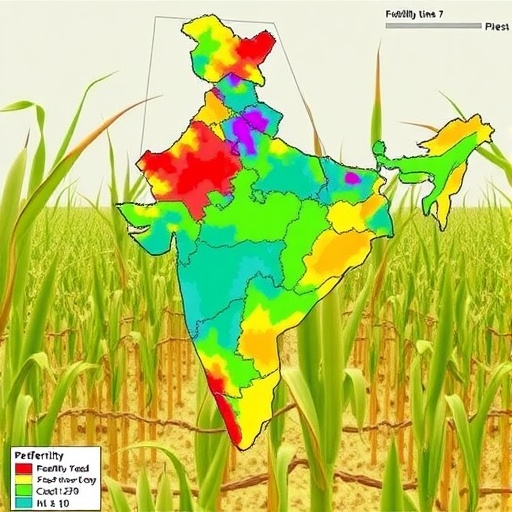In the pursuit of sustainable agricultural practices, researchers are continuously seeking innovative methodologies to enhance soil fertility management, particularly in regions facing challenges such as drought or limited resources. A recent study by Bhagwan et al. has shed light on the intricate dynamics of soil fertility in semi-arid maize systems in India, employing advanced techniques like geostatistics and fuzzy clustering to delineate soil fertility management zones. This research not only seeks to optimize agricultural productivity but also to safeguard the environmental integrity of these vulnerable regions.
The study begins by emphasizing the importance of soil fertility, a key factor that influences crop yield and sustainability. As agricultural practices evolve, understanding the spatial variability of soil properties is crucial for effective management. The semi-arid regions of India are characterized by their unique climatic conditions, which necessitate an adapted approach to soil fertility management. Crop production in these areas is often hindered by various factors, including erratic rainfall and nutrient-poor soils. Consequently, the necessity for targeted soil management practices becomes evident.
Bhagwan and colleagues implemented a robust research methodology designed to collect and analyze soil samples across varying locations within semi-arid landscapes. Using geostatistical tools, the researchers were able to assess spatial patterns in soil properties such as pH, organic matter content, and essential nutrient levels, including nitrogen and phosphorus. The meticulous collection and analysis of data revealed significant variations in soil fertility, highlighting the necessity of localized management strategies that address specific soil characteristics.
One of the pivotal aspects of this study is the application of fuzzy clustering, a technique that allows for more nuanced interpretations of soil data. Traditional clustering methods often categorize data points too rigidly, failing to capture the complexity of soil interactions. In contrast, fuzzy clustering acknowledges that soil properties may not fit neatly into distinct categories. Instead, it allows for a more flexible approach, recognizing that various soil types may share characteristics and overlapping attributes.
The results of this research underscore the profound implications of effective soil management in enhancing maize production. By delineating management zones, farmers can apply targeted interventions, such as soil amendments or fertilizer applications, specifically tailored to the needs of each zone. This targeted approach not only boosts crop yields but also minimizes the risk of over-fertilization, which can lead to nutrient runoff and environmental degradation.
Moreover, the study highlights the role of technology in modern agriculture. Utilizing geostatistical methods and machine learning techniques equips researchers and practitioners with the ability to process and analyze vast amounts of data with greater accuracy. This shift towards data-driven solutions is transforming the agricultural landscape, promoting smarter practices that elevate productivity while maintaining ecological balance.
The research conducted by Bhagwan et al. stands as a testament to interdisciplinary collaboration, merging agriculture, environmental science, and data analysis. The imperative for such collaborations is increasingly evident as global agricultural systems face unprecedented pressures from climate change, population growth, and resource scarcity. By fostering a deeper understanding of soil dynamics within the context of semi-arid maize systems, the study paves the way for future innovations in sustainable farming techniques.
As countries strive for food security, this research contributes crucial insights into optimizing agricultural practices in challenging environments. The elucidation of soil fertility management zones serves as a foundation for policy-makers and agronomists to develop actionable strategies that align with both economic viability and environmental stewardship.
In the broader scope of agricultural sustainability, the implications of this work extend beyond maize production in India. The methodologies employed and the findings obtained can be adapted and scaled to other semi-arid regions globally, where similar challenges persist. As researchers continue to explore innovative solutions to agricultural challenges, studies like these offer a glimmer of hope for establishing resilient food systems.
The journey toward sustainable agriculture is ongoing, and the insights gleaned from this study represent a critical step forward in empowering farmers. By lessening the guesswork traditionally associated with soil management and emphasizing the importance of localized strategies, the agricultural community can move towards a future where productivity and sustainability coexist harmoniously.
Ultimately, the study by Bhagwan et al. serves as a powerful reminder of the potential of science to address pressing agricultural challenges. In a world where the stakes for food security have never been higher, the integration of cutting-edge techniques in soil management showcases a blueprint for resilience and adaptability in farming. The knowledge gained from these findings not only enhances maize yield in India but also sets a precedent for similar endeavors in diverse agricultural landscapes worldwide.
As agriculture continues to navigate the complexities of climate change and resource constraints, the fusion of traditional wisdom with modern scientific techniques will be paramount. By emphasizing sustainable practices rooted in robust scientific research, farmers can meet the demands of the future while safeguarding the health of our planet.
Thus, as we reflect on the significant contributions of this research, it is evident that a multifaceted approach to agriculture, embracing technological advancements while remaining mindful of ecological systems, holds the key to a food-secure and sustainable future.
Subject of Research: Soil Fertility Management in Semi-Arid Regions
Article Title: Delineating soil fertility management zones using geostatistics and fuzzy clustering in semi-arid maize systems in India.
Article References: Bhagwan, P.V., Anjaiah, T., Ravali, C. et al. Delineating soil fertility management zones using geostatistics and fuzzy clustering in semi-arid maize systems in India. Environ Monit Assess 197, 1230 (2025). https://doi.org/10.1007/s10661-025-14608-z
Image Credits: AI Generated
DOI:
Keywords: Soil Fertility Management, Geostatistics, Fuzzy Clustering, Sustainable Agriculture, Semi-Arid Regions, Maize Production, Environmental Stewardship, Agricultural Sustainability.




